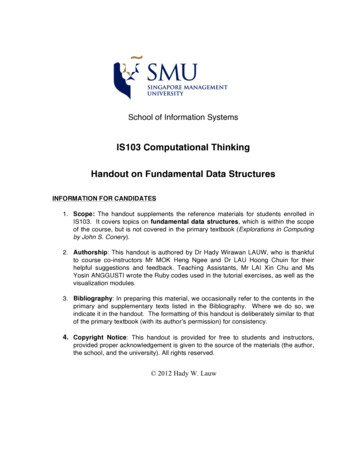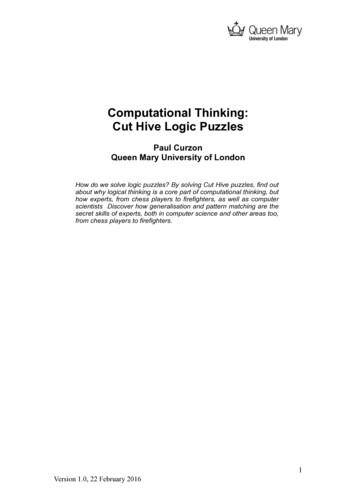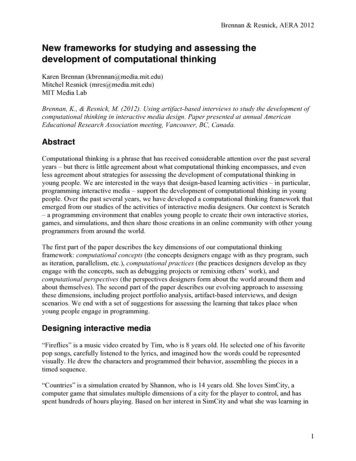
Transcription
School of Information SystemsIS103 Computational ThinkingHandout on Fundamental Data StructuresINFORMATION FOR CANDIDATES1. Scope: The handout supplements the reference materials for students enrolled inIS103. It covers topics on fundamental data structures, which is within the scopeof the course, but is not covered in the primary textbook (Explorations in Computingby John S. Conery).2. Authorship: This handout is authored by Dr Hady Wirawan LAUW, who is thankfulto course co-instructors Mr MOK Heng Ngee and Dr LAU Hoong Chuin for theirhelpful suggestions and feedback. Teaching Assistants, Mr LAI Xin Chu and MsYosin ANGGUSTI wrote the Ruby codes used in the tutorial exercises, as well as thevisualization modules.3. Bibliography: In preparing this material, we occasionally refer to the contents in theprimary and supplementary texts listed in the Bibliography. Where we do so, weindicate it in the handout. The formatting of this handout is deliberately similar to thatof the primary textbook (with its author’s permission) for consistency.4. Copyright Notice: This handout is provided for free to students and instructors,provided proper acknowledgement is given to the source of the materials (the author,the school, and the university). All rights reserved. 2012 Hady W. Lauw
Contents1 So the Last shall be First, and the First LastLinear data structures: stack, queue, and priority queue1.1 Stack . . . . . . . . . . . . . . . . . . . . . . . . .1.2 Queue . . . . . . . . . . . . . . . . . . . . . . . .1.3 Priority Queue . . . . . . . . . . . . . . . . . . .1.4 Summary . . . . . . . . . . . . . . . . . . . . . .2 Good Things Come in PairsModeling hierarchical relationships with binary trees2.1 Tree . . . . . . . . . . . . . . . . . . . . . . .2.2 Binary Tree . . . . . . . . . . . . . . . . . . .2.3 Traversals of a Binary Tree . . . . . . . . . . .2.4 Binary Search Tree . . . . . . . . . . . . . . .2.5 Summary . . . . . . . . . . . . . . . . . . . .3 It’s A Small World After AllModeling networks with graphs3.1 Real-world Networks . . .3.2 Graph . . . . . . . . . . .3.3 Traversals of a Graph . . .3.4 Topological Sorting . . . .3.5 Shortest Path . . . . . . .3.6 Summary . . . . . . . . .2. 3. 14. 19. 2224.242529323740.404248535859
1So the Last shall be First, and theFirst LastLinear data structures: stack, queue, and priority queueIn the second part (out of the three parts) of the course, we will concentrate on fundamentaldata structures, how to organize data for more efficient problem solving. The first type ofdata structure is index-based data structures, such as lists and hashtables. Each element isaccessed by an index, which points to the position the element within the data structure.This is covered in Chapter 6 of the primary textbook[Conery(2011)].In the three chapters of this handout, we will be expanding our coverage to three othertypes of data structures. In Chapter 1 (this chapter), we will explore linear data structures,whereby each element is accessed sequentially in a particular order. In the next two chapters, we will look at a couple of other data structures, where the main objective is to storethe relationship between elements. In Chapter 2, we will look at binary trees. In Chapter 3,we will look at graphs.There are several linear data structures that we will explore in this chapter. Unlike indexbased data structures where any element can be accessed by its index, in the linear datastructures that we will discuss in this chapter, only one element can be accessed at any pointof time. These data structures differ in the order in which the elements are accessed orretrieved. In stacks, the last item inserted will be the first to be retrieved. In queues, thefirst item inserted will also be the first item retrieved. We will also briefly cover priorityqueues, which maintain a sorted order of elements at all times, and retrieve the item withthe highest priority order first.2
31.1 Stack1.1 StackWe are familiar with the term ”stack” as used in the English language. It literally meansa pile of objects. We talk about a stack of coins, a stack of books, a stack of boxes, etc.Common among all these real-world scenarios is that the single object in a stack that iseasiest to access is the one at the top.This nature of stacks is known as LIFO, which stands for Last-In, First-Out. Using stack asa data structure means that we take care to ensure that the item we need to access first willbe put onto the stack last.Access to any element in a stack has to go through one of the following operations. push operation inserts a new element onto the top of the stack. peek operation returns the element currently at the top of the stack, but does notremove it. pop operation returns the element currently at the top of the stack and removes it fromthe stack. As a result, the element previously below the top element now becomes thetop element itself.In addition to the above operations that are valid only for stack, all the linear data structures also have new operation, which creates a new instance of the data structure, as wellas count operation, which returns the number of elements currently in the data structure.Tutorial ProjectThe tutorial exercises are provided in a file ‘lineardslab.rb’ that you can download from eLearn. Ensurethat the file ‘lineardslab.rb’ is in the same directory as when you start the IRB session. Start an IRBsession and load the module that will be used in this chapter. require ’lineardslab.rb’true include LinearDSLabObjectT1. Make a new stack object and save it in a variable named s: s Stack.new []This new stack is currently empty.T2. Let’s add a couple of strings to the new stack: s.push("grape") ["grape"] s.push("orange")["orange", "grape"]The top of the stack is the first element in the array. It is always the most recently addedelement. The bottom of the stack or the last element is the least recently added.T3. Let us visualize the stack: view stack(s) true
41 So the Last shall be First, and the First LastCan you see now there are two elements in the stack? Do the top and the bottom elementsmatch what you expect?T4. Add more strings to the stack: ["mango", "guava", "kiwi"].each { x s.push(x) } ["mango", "guava", "kiwi"]T5. Check the strings in the stack currently: s ["kiwi", "guava", "mango", "orange", "grape"] s.count5T6. We can find out what the topmost string in the stack is without removing it by using peek: s.peek "kiwi"The return value is “kiwi”. The visualization now “highlights” the top element by changingits color, as shown in Figure 1.1. However, the element is not removed yet.T7. Check that no string has been removed from the stack as a result of calling peek, and makesure there are still five strings in the stack: s ["kiwi", "guava", "mango", "orange", "grape"] s.count5T8. Remove a string from the stack by using pop and store it in a variable named t: t s.pop "kiwi"Do you see how the visualization changes to indicate that “kiwi” is no longer part of thestack?T9. Check that the topmost string has been removed from the stack s and is now stored in t: s ["guava", "mango", "orange", "grape"] t"kiwi"T10. Find out what the topmost string is now without removing it: s.peek "guava"This is the string added second last, which is now the topmost string after removing "kiwi".T11. Try a few more push, peek, and pop operations on your own.A Simple Application of StackIn computing, stacks are used in various applications. One application is to support theBackspace (on a PC) or delete (on a Mac) key on a computer keyboard. When you press thiskey, the last letter typed (Last-In) is the one deleted first (First-Out). Another application isto manage the function calls of a software program. A function f 1 may call another functionf 2 . In this case, f 1 may be “suspended” until f 2 completes. To manage this, the operating
51.1 StackFigure 1.1: Visualization of stack after peek is calledsystem maintains a stack of function calls. Each new function call is pushed onto the stack.Every time a function call completes, it is popped from the stack.To further appreciate how a stack is used in an application, we will explore one simpleapplication: checking for balanced braces. Braces are balanced if there is a matching closingbrace for each opening brace. For example, the braces in the string “a{b{c}d}” are balanced,whereas the braces in the string “ab{{c}d” are not balanced. This application is based on asimilar example in [Prichard and Carrano(2011)].Tutorial ProjectT12. Create an array of strings with balanced braces: t ["a", "{", "b", "{", "c", "}", "d", "}"] ["a", "{", "b", "{", "c", "}", "d", "}"]T13. A simpler way to do it is by “splitting” a string into its individual characters using split()method of a string, passing it an argument // (which is the space between characters). t "a{b{c}d}".split(//) ["a", "{", "b", "{", "c", "}", "d", "}"]T14. We now create a new stack to experiment with this application: s Stack.new []T15. Traverse the array, and whenever we encounter an opening brace, we push it into the stack: t.each { x s.push(x) if x "{" }T16. Check that the stack now contains two opening braces: s ["{", "{"]T17. Traverse the array again, and whenever we encounter a closing brace, we pop the topmoststring from the stack: t.each { x s.pop if x "}" }T18. Check that the stack is now empty: s []
61 So the Last shall be First, and the First LastBecause the number of opening and closing braces are equal, the same number of push andpop operations are conducted. Since the stack s is empty at the end, we conclude that thearray t contains balanced braces.T19. We now experiment with a new array with imbalanced braces: t "ab{{c}d".split(//) ["a", "b", "{", "{", "c", "}", "d"]T20. We run the previous push and pop operations in sequence: t.each { x s.push(x) if x "{" } t.each { x s.pop if x "}" }T21. Check the current status of the stack: s ["{"]In this case, there are two push operations, but only one pop operation, resulting in thestack containing an opening brace at the end. Since the resulting stack is not empty, weconclude that the array does not contain balanced braces.T22. Try the same set of commands for a different sequence of strings: t "ab}c{d".split(//) t.each { x s.push(x) if x "{" } t.each { x s.pop if x "}" }T23. Check the current status of the stack: s []The stack is empty, implying that the braces are balanced. However, this is not a correctconclusion, because although the numbers of opening and closing braces are the same, theyare out of sequence (the closing brace comes before the opening brace).The way of checking for balanced braces in the previous tutorial does not always producethe correct answer. This is because we push all the opening braces first, and then pop for allthe closing braces. We have disregarded the order in which the braces occur.Let us revisit what it means for an array to contain balanced braces. The braces arebalanced if:1. Each time we encounter a closing brace “}”, there is already a previously encounteredopening brace “{”.2. By the time we reach the end of the array, we have matched every “{” with a “}”, andthere is no remaining unmatched opening or closing brace.The right way of doing it is to push each opening brace when we encounter one duringthe traversal of the array, and to pop the topmost opening brace as soon as we encountereach closing brace . Therefore, in the out-of-sequence case, there will be an occasion whenwe try to pop the stack when it is empty. This should be flagged as an imbalanced case.The Ruby function shown in Figure 1.2 implements the above logic. It maintains a stacks and a boolean indicator balancedSoFar. It then iterates through the input array t,pushes each opening brace as it is encountered, and pops once for each closing brace. Thekey step to flag the out-of-sequence cases is to check that the stack is not empty when
71.1 Stack1: def check braces(t)2:s Stack.new3:balancedSoFar true4:i 05:while i t.count and balancedSoFar6:if t[i] "{"7:s.push(t[i])8:when “{” encountered, push into stackwhen “}” encountered, pop from stackelsif t[i] "}"9:if s.count 010:ensure that stack not empty whenpopping, otherwise not balanceds.pop11:else12:balancedSoFar false13:end14:end15:i 116:end17:return (balancedSoFar and s.count 0)balanced if stack is empty at the end18: endFigure 1.2: An algorithm to check balanced bracesInput arrayStack states1a{b{c}d}ab{{c}d23{{{{123{{{{Stack operations41.2.3.3.push “{“push “{“poppopStack empty: balanced1. push “{“2. push “{“3. popStack not empty: not balanced11. popa}b{cdStack empty when “}” isencountered: not balancedFigure 1.3: Traces of the algorithm to check balanced braces
81 So the Last shall be First, and the First Lastpopping, otherwise the balancedSoFar is set as false. At the end, the array containsbalanced braces if both the stack s is empty and balancedSoFar is true.We will now try this code, and verify that it indeed can identify the various cases ofbalanced and imbalanced braces.Tutorial ProjectT24. Create an array of strings with balanced braces: t "a{b{c}d}".split(//) ["a", "{", "b", "{", "c", "}", "d", "}"]T25. Use check braces to verify that the braces are balanced: check braces(t) trueThe trace of execution for this array is shown in the top row of Figure 1.3. It illustrates thestates of the stack after each push and pop operation. In Step 1, the brace “{” after ”a” ispushed onto the stack. In Step 2, the brace “{” after letter “b” is pushed, resulting in twoopening braces in the stack. In Step 3, a pop operation is run after the first “}”. Finally, inStep 4, another pop operation after the second “}”. Since in the end, the stack is empty, thebraces in t are balanced.T26. Create a new array with imbalanced braces: t "ab{{c}d".split(//) ["a", "b", "{", "{", "c", "}", "d"]T27. Use check braces to verify that the braces are not balanced: check braces(t) falseThe trace of execution for this array is shown in the middle row of Figure 1.3.T28. Create an array with out-of-sequence braces: t "a}b{cd".split(//) ["a", "}", "b", "{", "c", "d"]T29. Use check braces.rb to verify that the braces are not balanced although there is equalnumber of opening and closing braces: check braces(t) falseThe trace of execution for this array is shown in the bottom row of Figure 1.3.Array-based Implementation of a Stack in RubySo far we have used a stack and its various operations without knowing how it is implemented, which is how it should be. As we discussed earlier in the course, an abstract datatype (such as a stack) is defined by the operations, not by a specific implementation.Here we will explore an implementation written in Ruby based on Array object. In thisarray-based implementation, we use an array variable called items to store the elementsin the stack.items Array.newWe then define the operations in terms of array operations on this array items, as follows:
91.1 Stackdef push(v)out items.unshift(v)0orange s.push(“kiwi”)return out1grape "kiwi"endBefore0kiwi12orangegrapeunshiftAfter(a) Implementation of pushdef peekout items.firstreturn out0kiwi12orange s.peekgrape "kiwi"end0kiwi12orangeBeforegrapeAfter(b) Implementation of peekdef popout items.shiftreturn outend012kiwikiwiorange s.pop0orangegrape "kiwi"1grapeBeforeAfter(c) Implementation of popFigure 1.4: Array-based implementation of a stack and its operations Figure 1.4(a) shows the implementation of the push operation. It uses the operationunshift of an array, which inserts the new element v as the first element at position0, and shifts all the existing elements in the array to larger indices. Figure 1.4(b) shows the implementation of the peek operation. It returns the firstelement of the array items (at position 0), and it does not change the composition ofthe array. Figure 1.4(c) shows the implementation of the pop operation. It uses the operationshift of an array, which removes the first item at 0, and shifts all the existing elements in the array to smaller indices.Complexity. The peek has complexity of O(1), because it involves simply accessingan array element by index. In the above implementation, we leverage on Ruby’s shiftand unshift operations for simplicity. Every push or pop operation requires shifting allelements by one position, the complexity of these operations will be O(n), where n is thecurrent count of elements.ChallengeCan you think of alternative implementations of push and pop operations with O(1) complexity?shift
101 So the Last shall be First, and the First Last1: def fibonacci(n)2:if n 03:return 04:elsif n 15:return 16:else7:return fibonacci(n-1) fibonacci(n-2)8:end9: end(a) :def fibonacci stack(n)s Stack.news.push(n)result 0while s.count 0current s.popif current 0result 0elsif current 1result 1elses.push(current - 2)s.push(current - 1)endendreturn resultend(b) Non-recursive using stackFigure 1.5: Algorithms to compute Fibonacci numbersStack and RecursionEarlier in Week 4 of the course, we learnt about recursion as a problem solving technique.When a recursive algorithm is compiled, it is typically converted into a non-recursive formby the compiler. To better understand how recursion is related to stacks, let us take a lookat how a recursive algorithm can be re-written into an iterative algorithm using stack.We will first see a simple example based on Fibonacci series, and later we will re-visitbinary search rbsearch to search for an item in an array.Fibonacci SeriesFibonacci series are the numbers in the following sequence: 0, 1, 1, 2, 3, 5, 8, 13, 21, 34, . . . Inmathematical terms, the n-th number in the series is the sum of the (n 1)-th and (n 2)-thnumbers. The first and second numbers in the series are 0 and 1.Figure 1.5(a) shows a recursive algorithm fibonacci(n) to compute the n-th numberin the Fibonacci series for n 0. For the base case n 0, it returns 0. For the other
1.1 Stack11base case n 1, it returns 1. Otherwise, it makes two recursive calls fibonacci(n-1)and fibonacci(n-2) and adds up the outputs.To convert a recursion into a non-recursive version, we follow several simple steps.1. Create a new stack2. Push initial parameters onto the stack3. Insert a while loop to iterate until the stack is empty or the return condition is met.a) Pop the current parameter to be processed from stackb) If it is a base case, do the base case computation and do not make any morerecursive calls.c) If it is a reduction step, we replace the recursive calls with appropriate pushoperations to insert the next set of parameter onto the stack. Take care to pushlast the parameters to be processed first.Figure 1.5(b) shows a non-recursive algorithm fibonacci stack(n), which uses astack. For the base cases n 0 and n 1, it conducts the addition operations. Insteadof making recursive calls, we push the next two parameters, n-1 and n-2, onto the stack.Take note that in Figure 1.5(a), we call fibonacci(n-1) before fibonacci(n-2). InFigure 1.5(b), we push n-2 before n-1. This is because to mimic the recursive call to n-1first, we need to push it last onto the stack.Binary SearchLet us now revisit the recursive algorithm to search an array in Figure 5.11 (page 124) in[Conery(2011)]. The algorithm searches a sorted array a, in the range of positions fromlower to upper, for the position where the value k occurs. It starts from the full range,and checks the middle position mid. If the key k is not at mid, it recursively calls the sameoperation, but with a smaller range, either from lower to mid, or from mid to upper.Let us now see how a similar algorithm can be implemented without recursion, but usinga stack instead. Figure 1.6 shows such an algorithm. It starts by pushing the initial boundarypositions lower and upper onto the stack. It then operates on the top-most items of thestack until either the key k is found, or the stack is empty (meaning k cannot be found).Note that items are popped (upper first, then lower) in opposite order in which they arepushed (lower first, then upper).Understanding how recursion can be “implemented” using stack will help us understandthe sequence in which recursive calls are made. Later, in the tutorial exercises, we willexperiment with how a recursive algorithm will continuously make further recursive callsuntil the base cases are reached (which can be simulated by pushing new parameter valuesonto a stack), and then sequentially return the outputs to the previous recursive calls (whichcan be simulated by popping “completed” parameter values from the stack).ChallengeWhat are the advantages and disadvantages of using recursion versus using stack?
121 So the Last shall be First, and the First Last1: def rbsearch stack(a, k, lower -1, upper a.length)2:s Stack.new3:s.push(lower)4:s.push(upper)5:while s.count 06:upper s.pop7:lower s.pop8:mid (lower upper)/29:return nil if upper lower 110:return mid if k a[mid]11:if k a[mid]12:s.push(lower)13:s.push(mid)14:if item is found or no more items,returnif item is not found yet, push newsearch boundaries into the stacks.push(mid)16:s.push(upper)17:19:operate on the top-most values ofthe stackelse15:18:start by pushing the initial valuesinto the stackendendendFigure 1.6: A non-recursive algorithm for rbsearch using stackTutorial ProjectThe tutorial exercises are provided in a file ‘lineardslab.rb’ that you can download fromeLearn. Ensure that the file ‘lineardslab.rb’ is in the same directory as when you start theIRB session. Start an IRB session and load the module that will be used in this chapter. require ’lineardslab.rb’true include LinearDSLabObjectT30. First, test the recursive version of the fibonacci method. fibonacci(0) 0 fibonacci(1) 1 fibonacci(2) 1 fibonacci(3) 2 fibonacci(4) 3T31. Make sure the stack-based version also produces the same outputs.
131.1 Stack fibonacci stack(0)0fibonacci stack(1)1fibonacci stack(2)1fibonacci stack(3)2fibonacci stack(4)3T32. To see the sequence of recursive calls, we will insert a probe to fibonacci(n) method andprint out each n being recursively called. Source.probe("fibonacci", 2, "puts n") true trace {fibonacci(4)}432101210Trace by hand the sequence of recursive calls for fibonacci(4). Is it the same as theabove?T33. Let’s compare this sequence to the stack-based version. We will insert another probe tofibonacci stack(n) method and print out the content of stack s in each iteration. Source.probe("fibonacci stack", 6, "puts s") true trace {fibonacci stack(4)}[4][3, 2][2, 1, 2][1, 0, 1, 2][0, 1, 2][1, 2][2][1, 0][0]Do you observe that as the iteration goes on, the sequence of elements occupying the top ofthe stack mirrors the sequence of recursive calls in the previous question?T34. Trace several more runs of fibonacci and fibonacci stack for different values of n. Doyou understand the sequence of recursive calls, and the sequence of stack operations?T35. Make a small test array for rbsearch (which is sorted). a TestArray.new(8).sort [6, 38, 45, 48, 55, 57, 58, 92]T36. Search for a value that exists in the array, and compare the outputs of rbsearch andrbsearch stack
141 So the Last shall be First, and the First Last rbsearch(a, 38)1 rbsearch stack(a, 38)1T37. Search for a value that does not exist in the array, and compare the outputs of rbsearchand rbsearch stack rbsearch(a, 16) nil rbsearch stack(a, 16)nilT38. Attach a probe to rbsearch to print brackets around the region being searched at each call: Source.probe("rbsearch", 2, "puts brackets(a, lower, upper)") trueT39. Trace a call to rbsearch: trace { rbsearch(a, 92) }[6 38 45 48 55 57 58 92]6 38 45 [48 55 57 58 92]6 38 45 48 55 [57 58 92]6 38 45 48 55 57 [58 92] 7T40. Attach a probe to rbsearch stack to print brackets around the region being searched afterpopping the lower and upper values from the stack: Source.probe("rbsearch stack", 8, "puts brackets(a, lower, upper)") trueT41. Trace a call to rbsearch stack: trace { rbsearch stack(a, 92) }[6 38 45 48 55 57 58 92]6 38 45 [48 55 57 58 92]6 38 45 48 55 [57 58 92]6 38 45 48 55 57 [58 92] 7Is it similar to the trace of the recursive version of binary search rbsearch?T42. Trace several more runs of rbsearch and rbsearch stack for different input arrays.Do you understand why the sequence of operations for the recursive and the non-recursiveversion are similar?1.2 QueueIn contrast to stacks which have LIFO property, queues are described as FIFO or First-In,First-Out. In other words, the next item to be accessed is the earliest item put into thequeue.Access to any element in a queue is allowed through one of the following operations: enqueue inserts a new element to the last position or the tail of the queue peek returns the element currently at the first position or the head of the queue, butdoes not remove it.
151.2 Queue dequeue operation returns the element currently at the head of the queue, and removes it from the queue. As a result, the element following the removed element nowoccupies the first position.Tutorial ProjectThe tutorial exercises are provided in a file ‘lineardslab.rb’ that you can download from eLearn. Ensurethat the file ‘lineardslab.rb’ is in the same directory as when you start the IRB session. Start an IRBsession and load the module that will be used in this chapter. require ’lineardslab.rb’true include LinearDSLabObjectT43. Make a new queue object and save it in a variable named q: q Queue.new []This new queue is currently empty.T44. Let’s add a string to the new queue: q.enqueue("grape") ["grape"]T45. We can also use operator to enqueue new elements at the tail: q "orange" ["grape", "orange"]The first element in the queue is the head, which is also the least recently added. The lastelement in the queue is the tail, which is also the most recently added.T46. We can visualize the current state of the queue: view queue(q) trueDo the elements at the head and the tail respectively match your expectation?T47. Add more strings to the queue: ["mango", "guava", "kiwi"].each { x q x } ["mango", "guava", "kiwi"]T48. Check the strings in the queue currently: q ["grape", "orange", "mango", "guava", "kiwi"]T49. We can find out what the first string in the queue is without removing it by using peek: q.peek "grape" q["grape", "orange", "mango", "guava", "kiwi"]Note that no string has been removed from the queue. The state of the queue after peek iscalled can be visualized, as shown in Figure 1.7.T50. Remove a string from the queue by using dequeue and store it in a variable named t: t q.dequeue "grape"
161 So the Last shall be First, and the First LastFigure 1.7: Visualization of queue after peek is calledDo you observe in the visualization how the element at the head is removed after thedequeue is called?T51. Check that the first string has been removed from the queue q and is now stored in t: q ["orange", "mango", "guava", "kiwi"] t"grape"T52. A synonym for dequeue is the shift operator: t q.shift "orange"A Simple Application of QueueQueues are commonly found in real life. It is used to maintain an ordering that favors thosethat arrive earlier over those that arrive later. In computing, queues have many applications.In a multitasking operating system, different software applications claim access to the CPU,and the operating system maintains a schedule of which application runs. Often times, aqueue may be a suitable structure for this.To more vividly appreciate the usage of queue, we now explore a simple application:recognizing palindromes. A palindrome is a string character that reads the same, whetherread from left to right, or from right to left. There are many examples of palindromes in theEnglish language, such as madam, radar, refer, etc.How do we recognize a palindrome? Remember that a queue has the FIFO property.The first item entering a queue is also the first item leaving the queue. When we insert(enqueue) letters in a word from left to right into a queue, we are going to “read” from leftto right as well when we access (dequeue) them from the queue. In contrast, a stack hasthe LIFO property. When we insert (push) letters in a word from left to right into a stack,we are going to “read” from right to left when we access (pop) them from the stack. Hence,if both a queue and a stack read the same sequence of letters, the word is a palindrome.
171.2 Queue1: def is palindrome(v)2:t v.split(//)3:q Queue.new4:s Stack.new5:t.each { x q.enqueue(x) }6:t.each { x s.push(x) }7:while s.count 08:left q.dequeue9:right s.pop10:return false if left ! right11:end12:return true13: endFigure 1.8: An algorithm to recognize palindromesTutorial ProjectT53. Create a new array that contains letters in a palindrome: t "pop".split(//) ["p", "o", "p"]T54. Insert the array elements into a queue: q Queue.new [] t.each { x q.enqueue(x) }["p", "o", "p"]T55. Insert the array elements into a stack: s Stack.new [] t.each { x s.push(x) }["p", "o", "p"]T56. Read the left-most letter from queue, and the right-most letter from stack, and check thatthey are the same: left q.dequeue "p" right s.pop"p" left righttrueThe first and last letters are
Yosin ANGGUSTI wrote the Ruby codes used in the tutorial exercises, as well as the visualization modules. 3. Bibliography: In preparing this material, we occasionally refer to the contents in the primary and supplementary texts listed in the Bib










